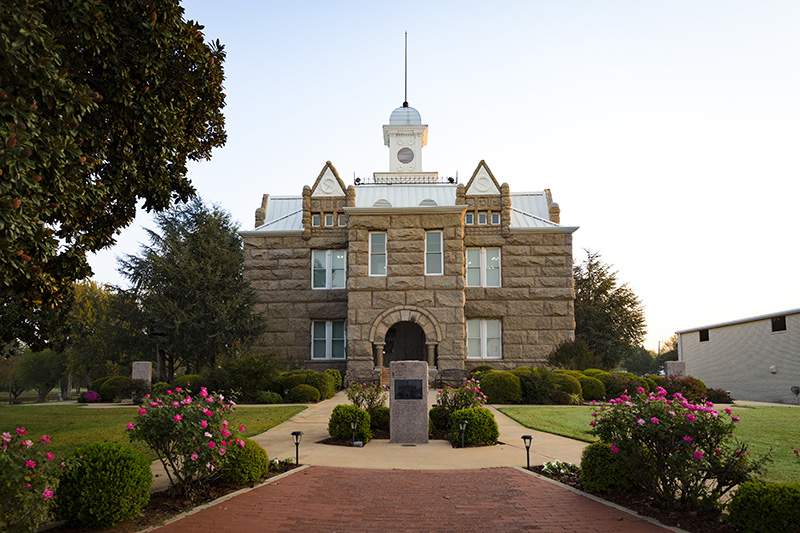The Chickasaw National Capitol: 125 Years of Endurance

This article appeared in the December 2023 edition of the Chickasaw Times
After being elected Chickasaw Governor in 1896, Robert M. Harris actively promoted the construction of a new Chickasaw National Capitol. He proposed the sale of native red granite from his land north of Tishomingo, which would cover the outside of the new building. Chickasaw legislators passed an act in 1897 that provided the funds and created a three-person committee — William Rennie, Charles Carter and R. L. Murray — who would assist Governor Harris with planning the building’s construction. The committee signed a contract April 7, 1898, with contractor C. P. Shaeffer, determining his salary and establishing a completion date for construction by Aug. 31, 1898. Committee members also decided that the granite building would be two stories tall, provide steam heat and gas lights and house a senate chamber, assembly hall and six offices.
In the early months of 1898, as contractors demolished the old brick Capitol, miners were at work extracting and cutting the granite from Governor Harris’ quarries. Tribal leaders wanted to salvage as much as possible from the historic brick Capitol. It was decided that the interior walls of the new Capitol would be lined with bricks from the old building.
The cornerstone for the granite Capitol was laid in June, where a formal ceremony was conducted by Judge Colbert Burris. The granite building was completed in the fall of 1898, at an estimated total cost of $30,000. In August, an election for Chickasaw Governor took place in Tishomingo. Chickasaw voters were asked to decide between Governor Robert M. Harris and the opposing candidate Douglas H. Johnston. Harris was defeated in the election by Johnston, who became the first and only Chickasaw Governor to serve in the Capitol.
On Nov. 17, 1898, a grand dedication ceremony marked the completion of the granite Capitol. It was reported that Governor Johnston and former Governor Harris led the procession of Chickasaw leaders and invited guests into the Capitol to begin the evening’s celebration.
The Chickasaw National Capitol building served as the seat of Chickasaw government from 1898 until Oklahoma statehood in 1907. Following statehood, tribal governments were severely restricted by the federal government and all tribally owned government buildings were required to be vacated. Governor Johnston continued his work at his home in Emet, Oklahoma. After 1910, the Capitol building was occupied by Johnston County and utilized as a courthouse. Because of the building’s historic significance and majestic architecture, the Chickasaw National Capitol was added to the National Register of Historic Buildings in 1971.
The Chickasaw Nation signed a purchase agreement with Johnston County in 1988 acquiring ownership of the Capitol once again. After regaining ownership, the Chickasaw Nation completed a full restoration of the building. The first floor of the Capitol now houses an exhibit space, with the main area focusing on Chickasaw government history during the Indian Territory years. Also on the first floor, the office of Chickasaw Governor Douglas H. Johnston and the adjoining National Secretary’s vault have been restored to look as they did in 1898. Captivating and inspiring images are on display throughout the Capitol, including a rotating photograph and exhibit room on the first floor.
Outside the building, the beautifully landscaped Capitol grounds and outdoor attractions provide a peaceful sanctuary. Created by the late Oklahoma Master Artist Enoch Kelly Haney, the bronze statue of Chickasaw leader Piominko was installed and dedicated in 2014. Piominko stands as guardian of the building on the south side of the Capitol grounds. On the north side, a bronze statue of Governor Douglas H. Johnston was completed in 2019 by well-known artist James Blackburn. Governor Johnston is a welcoming symbol for visitors of the grounds.
Also on the grounds, the National Well Exhibit was completed in 2005. Using old photographs, the well house and the stone wall surrounding the well were recreated to look as it did in 1892 at the time of its original construction.
After 125 years since its construction, the Capitol serves as an enduring reminder of the great accomplishments of the Chickasaw Nation and continues to stand proud and tall as a monument to all Chickasaw people.